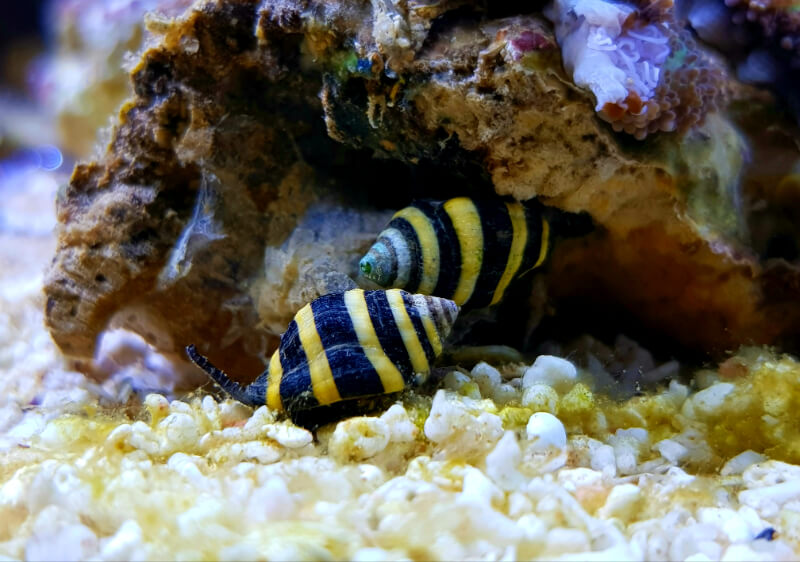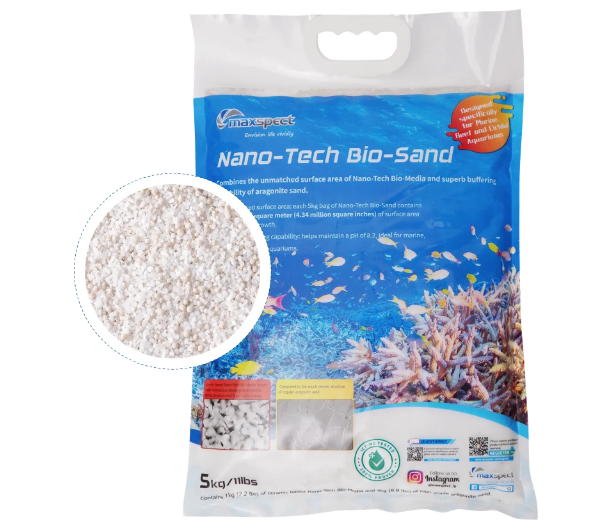Welcome fellow saltwater aquarists! The tiny and charismatic Bumblebee Snails are a fantastic addition to any saltwater aquarium, and we’re here to provide you with some essential information to ensure their well-being.
These snails are excellent natural scavengers, diligently cleaning up leftover food and algae, helping to maintain a clean and healthy tank.
If you are a beginner fish keeper, these snails will be great to know what goes into maintaining an organism in a tank, so keep reading.
Species Summary
The Bumblebee Snail or known by its scientific name as Engina mendicaria, is a sea snail that is a marine gastropod mollusk in the family Pisaniidae. This snail is also known as a striped enigma and wasp snail.
These snails are popular not only because of their appearance, but also because they are known as the powerhouse of your saltwater aquarium. These are the type of snails that clean the tank that they live in, making your work much easier. However, you cannot depend on the snail alone to clean the whole tank. The care for the snail is extremely easy as well, thus a perfect starter for people with little experience in fish keeping.
In the wild, the snails are found in Indo-Pacific regions as they originated from Indonesia, but now they can be found as far as Kenya and Florida. They work great in a community tank due to their being super friendly and peaceful.
Appearance
The appearance of the bumblebee snail is what attracts most people to it since as you can probably guess, the snail looks like a bumblebee.
The shells of the Engina mendicaria have black stripes, and in between, they have white to yellowish stripes, making them resemble a bee or a wasp. Also, the color is not faded; the shell is very vibrant and well-distinguished between the light-colored stripes and black stripes. In fact, the shells of the bumblebee have been used to make jewelry for a very long time now.
When it comes to the body, it is neutral in color and not really visible. You can only see its proboscis or its mouth, which the snail uses to move around and search for food.
Lifespan
In captivity, the average lifespan of a Bumblebee Snail is about two years. To determine the age of the snail, researchers look at the rings made of calcium on the shells of the snails but this is quite complicated due to their tiny size (a magnifying instrument is needed).
Two years is actually not too bad for a gastropod of this size. And since this is just an approximation, your bumblebees can live much longer if you keep them in a tank that is well maintained and provides enough nutrients.
Author Note: The seller you got the snail from also determines the lifespan. The more well-kept the snail is, the longer it will stay in your aquarium so it is quite important to select the right seller.
Average Size
The average size of the bumblebee snail can range from 0.5 inches to 0.6 inches. The snail is small enough to go in between crevices of rocks and clean the areas.
If you want the snail to achieve the biggest possible size, give it proper food and calcium to allow it to grow. Also, the genetics of the batch of the snail also makes a huge difference; some bumblebee snails are just known to get bigger than others.
Snail Care
There is nothing too complicated about caring for these tiny creatures. Just make sure to have a proper tank size that is cleaned regularly.
Tank Size
When you decide to keep a snail, the most important thing to consider is that the snail has a comfortable tank size. If the tank is too small, the snail will not be able to stay healthy for long.
The minimum recommended tank size for a bumblebee snail is 5 gallons, but maintaining a tank this small can be hard as they are susceptible to sudden temperature changes.
This snail needs steady water parameters. Also, the bumblebee snail is perfect for a community tank, so most people have them in larger tanks with other bigger fish species.
Water Parameters
These tiny creatures are sensitive to water temperatures so it is important to monitor and manage any fluctuations as soon as you detect them. Moreover, also make sure to have enough calcium in your tank because the bumblebee snails need it to build their shells.
Temperature: 72 to 78°F
pH: 8.1 to 8.4
Specific Gravity: 1.023 to 1.025.
Calcium levels: 350 to 450
Magnesium: 1300 to 1350
Tank Set Up
Moving on from the basics, the tank setup for your Engina mendicaria is also important. Even if you keep them in a community tank, there are some requirements that the snail requires.
As you know, they love going into small crevices, so they should have enough space with a lot of hiding places like logs, caves, and driftwood. Live rocks are also a very important addition to their tank. Another important addition to the tank is a deep sand bed. One or two inches of sand should be enough for them to burrow into it.
Author Note: A heater could come in handy to keep the right temperature as well as an appropriate filter to correct the water parameters. Do not skimp on a water testing kit, as it will help you identify your tank’s problems before it becomes deadly.
Lighting
Since the snail is nocturnal, it stays up at night and sleeps when there is light outside. This means you need to adjust accordingly to their schedule. Make sure not to keep the lights too close to the tank. Still, the snail is not too picky when it comes to light intensity and distance.
Author Note: A few sources recommend exposure to natural sunlight.
Snail Filtration
These snails do not tolerate high levels of nitrate or ammonia. Along with that, any amount of copper in the water is deadly for them. Therefore, a filter is very important to maintain the correct water conditions. If you keep them in a small tank, a sponge filter with a chemical filter will do the job, but for larger tanks, you need a proper HOB filter or canister filter.
Snail Acclimation
Before acclimation, the tank should be fully cycled as these snails need helpful bacteria and do not survive if the tank is not mature.
A simple acclimation method is to float the bag that the snail came in and slowly let the temperature of the tank and the bag be one. After that, open the bag and let the water exchange between the bag and tank to reach a normal pH range. Let the snail move into the tank by itself, do not force it in.
Are Bumble Bee Snails Reef Safe?
Yes, fortunately Bumblebee snails are reef safe. Besides not attacking the reef they also do not compete for nutrition. In fact, when the snail is hungry, it can attack polychaetes and vermetid snails. These are invasive snail species that attack reefs but you should not depend on the bumblebee snail to deal with large infestations because they are too slow.
Common Possible Diseases & Prevention
Just like most other invertebrates, the bumble bee snail is sensitive to copper-based medications, high nitrate levels, and even the slightest fluctuation in water parameters. But no specific diseases affect the snail or none that we know of.
Author Note: The snail can still carry diseases to other fishes in the tank. So you might want to quarantine your new bumblebee snail for 7 to 8 weeks before adding it to your tank. While in quarantine you could test for diseases with non-expensive fish to see if they develop any infections.
What Do Bumblebee Snails Eat?
The diet of the bumblebee snail is both omnivorous and carnivorous. It can eat a plant-based diet, but it prefers invertebrates leftovers and other small organisms.
Their feeding behavior consists of finding meaty foods from live rocks and sand. They usually burrow in the sand and look for worms there. If there aren’t enough meaty leftovers from your other fish, you can introduce mysis shrimp, brine shrimp, or even chopped frozen shrimp.
Author Note: If you are looking for algae eaters you will need to look for other species of snails because these bumblebees not only do not eat it, they will actually eat small algae eater invertebrates like polychaetes.
Behavior and Temperament
Bumblebee snails are very peaceful and mind their own business. They are too small to attack other living organisms and they are actually known to work with many tank mates due to their peaceful nature. Most of the time, these snails just burrow in sand or hide behind rocks at the lower part of the tank.
Bumble Bee Snail Tank Mates & Predators
Since the bumblebee snail is so small, any fish that is aggressive and larger is a predator. Sadly, that includes many fish including larger shrimps and crabs. Therefore, it is best to avoid coral-banded shrimp, wrasses, and hermit crabs.
As far as tank mates, the snail does not harm any shrimp or snails of similar size, so if you want to share the tank with the Sexy Shrimp or the Red Fire Shrimp you will be fine. Outside of the aforementioned predators, most other fish and crustaceans work with the bumblebee snail. Other options to share the tank with your bumblebee snail are as follows.
- Fighting conch snail
- Astrea snail
- Mexican turbo snail
- Cerith snail

Breeding
It would be great to be able to breed these good looking snails, unfortunately, there are not any recorded cases of successfully breeding bumblebee snails in captivity.
There are many reasons for this, such as these being one of the only snails that have sexual reproduction, and no one can tell their sex apart due to their size. Imagine guessing their sex and adding lots of bumblebees into your aquarium to end up with all males or all females? Another issue is figuring out how to provoke spawning although a few sources suggest experimenting with temperatures and sunlight.
Author Note: snail offsprings are quite tasty to other fish so these would need to be isolated for protection as soon as they show up (if they ever do). In summary, we don’t recommend investing time and money trying to breed bumblebee snails.
Conclusion
We hope you enjoyed reading as much as we enjoyed writing this detailed guide about Bumblebee Snails. These snails play a crucial role in keeping your aquarium clean by devouring leftover food and pesky algae. By providing them with a suitable environment, regular feeding, and keeping an eye on their population, you can enjoy the benefits of their natural scavenging abilities.
Additionally, their unique striped appearance adds a touch of vibrant charm to your underwater landscape. So, embrace these tiny helpers and let them contribute their magic to your saltwater aquarium.
We offer more information in our Saltwater Care Guides in case you are looking for additional knowledge and don’t forget to tag us on Facebook when sharing photos of your cute snails. Happy snail-keeping, and may your Bumble Bee Snails thrive and bring joy to your aquatic world!



